Electrochemical Strategies for MicroRNA Quantification Leveraging Amplification and Nanomaterials: A Review
Abstract
1. Introduction
2. Electrochemical miRNA Biosensors
2.1. Fundamental Designs of Electrochemical Biosensors for MicroRNA Quantification
2.2. Emerging Architectures and Amplification Techniques for Electrochemical miRNA Detection
2.3. Challenges and Advances in Nanomaterial and Amplification Strategy Integration
3. Redox-Reporting Methods in Electrochemical miRNA Biosensors
3.1. Redox-Labeled Hybridization Modes
3.2. Redox Mediators in Label-Free Electrochemical miRNA Biosensing
3.3. Intercalation-Based Redox Probes for Label-Free miRNA Detection
4. Challenges and Perspectives
5. Conclusions and Future Outlook
Author Contributions
Funding
Data Availability Statement
Conflicts of Interest
References
- Ranganathan, K.; Sivasankar, V. MicroRNAs—Biology and clinical applications. J. Oral Maxillofac. Pathol. 2014, 18, 229–234. [Google Scholar] [CrossRef] [PubMed]
- Ha, T.Y. MicroRNAs in Human Diseases: From Cancer to Cardiovascular Disease. Immune Netw. 2011, 11, 135–154. [Google Scholar] [CrossRef] [PubMed]
- Chakrabortty, A.; Patton, D.J.; Smith, B.F.; Agarwal, P. miRNAs: Potential as Biomarkers and Therapeutic Targets for Cancer. Genes 2023, 14, 1375. [Google Scholar] [CrossRef] [PubMed]
- Singh, V.; Sen, A.; Saini, S.; Dwivedi, S.; Agrawal, R.; Bansal, A.; Shekhar, S. MicroRNA Significance in Cancer: An Updated Review on Diagnostic, Prognostic, and Therapeutic Perspectives. Ejifcc 2024, 35, 265–284. [Google Scholar]
- Lu, D.P.; Read, R.L.; Humphreys, D.T.; Battah, F.M.; Martin, D.I.; Rasko, J.E. PCR-based expression analysis and identification of microRNA. J. RNAi Gene Silenc. Int. J. RNA Gene Target. Res. 2005, 1, 44–49. [Google Scholar]
- Zippelius, A.; Kufer, P.; Honold, G.; Köllermann, M.W.; Oberneder, R.; Schlimok, G.; Riethmüller, G.; Pantel, K. Limitations of reverse-transcriptase polymerase chain reaction analyses for detection of micrometastatic epithelial cancer cells in bone marrow. J. Clin. Oncol. 1997, 15, 2701–2708. [Google Scholar] [CrossRef]
- Jaksik, R.; Iwanaszko, M.; Rzeszowska-Wolny, J.; Kimmel, M. Microarray experiments and factors which affect their reliability. Biol. Direct 2015, 10, 46. [Google Scholar] [CrossRef]
- Hunt, A.; Slaughter, G. Electrochemical Detection of Prostate Cancer—Associated miRNA-141 Using a Low-Cost Disposable Biosensor. Biosensors 2025, 15, 364. [Google Scholar] [CrossRef]
- Yáñez-Sedeño, P.; Agüí, L.; Campuzano, S.; Pingarrón, J.M. What Electrochemical Biosensors Can Do for Forensic Science? Unique Features and Applications. Biosensors 2019, 9, 127. [Google Scholar] [CrossRef]
- Zhang, L.; Guo, W.; Lv, C.; Liu, X.; Yang, M.; Guo, M.; Fu, Q. Electrochemical biosensors represent promising detection tools in medical field. Adv. Sens. Energy Mater. 2023, 2, 100081. [Google Scholar] [CrossRef]
- Liyanage, T.; Alharbi, B.; Quan, L.; Esquela-Kerscher, A.; Slaughter, G. Plasmonic-based biosensor for the early diagnosis of prostate cancer. ACS Omega 2022, 7, 2411–2418. [Google Scholar] [CrossRef]
- Bharti, A.; Mittal, S.; Rana, S.; Dahiya, D.; Agnihotri, N.; Prabhakar, N. Electrochemical biosensor for miRNA-21 based on gold-platinum bimetallic nanoparticles coated 3-aminopropyltriethoxy silane. Anal. Biochem. 2020, 609, 113908. [Google Scholar] [CrossRef]
- Liyanage, T.; Lai, M.; Slaughter, G. Label-free tapered optical fiber plasmonic biosensor. Anal. Chim. Acta 2021, 1169, 338629. [Google Scholar] [CrossRef] [PubMed]
- Arlett, J.L.; Myers, E.B.; Roukes, M.L. Comparative advantages of mechanical biosensors. Nat. Nanotechnol. 2011, 6, 203–215. [Google Scholar] [CrossRef] [PubMed]
- Zhang, X.; Pu, H.; Sun, D.-W. Photothermal detection of food hazards using temperature as an indicator: Principles, sensor developments and applications. Trends Food Sci. Technol. 2024, 146, 104393. [Google Scholar] [CrossRef]
- Sin, M.L.; Mach, K.E.; Wong, P.K.; Liao, J.C. Advances and challenges in biosensor-based diagnosis of infectious diseases. Expert Rev. Mol. Diagn. 2014, 14, 225–244. [Google Scholar] [CrossRef] [PubMed]
- Campuzano, S.; Pedrero, M.; Gamella, M.; Serafín, V.; Yáñez-Sedeño, P.; Pingarrón, J.M. Beyond Sensitive and Selective Electrochemical Biosensors: Towards Continuous, Real-Time, Antibiofouling and Calibration-Free Devices. Sensors 2020, 20, 3376. [Google Scholar] [CrossRef]
- El Aamri, M.; Yammouri, G.; Mohammadi, H.; Amine, A.; Korri-Youssoufi, H. Electrochemical Biosensors for Detection of MicroRNA as a Cancer Biomarker: Pros and Cons. Biosensors 2020, 10, 186. [Google Scholar] [CrossRef]
- Jolly, P.; Batistuti, M.R.; Miodek, A.; Zhurauski, P.; Mulato, M.; Lindsay, M.A.; Estrela, P. Highly sensitive dual mode electrochemical platform for microRNA detection. Sci. Rep. 2016, 6, 36719. [Google Scholar] [CrossRef]
- Miglione, A.; Raucci, A.; Amato, J.; Marzano, S.; Pagano, B.; Raia, T.; Lucarelli, M.; Fuso, A.; Cinti, S. Printed Electrochemical Strip for the Detection of miRNA-29a: A Possible Biomarker Related to Alzheimer’s Disease. Anal. Chem. 2022, 94, 15558–15563. [Google Scholar] [CrossRef]
- Rafiee-Pour, H.-A.; Behpour, M.; Keshavarz, M. A novel label-free electrochemical miRNA biosensor using methylene blue as redox indicator: Application to breast cancer biomarker miRNA-21. Biosens. Bioelectron. 2016, 77, 202–207. [Google Scholar] [CrossRef] [PubMed]
- Ganguly, A.; Benson, J.; Papakonstantinou, P. Sensitive chronocoulometric detection of miRNA at screen-printed electrodes modified by gold-decorated MoS2 nanosheets. ACS Appl. Bio Mater. 2018, 1, 1184–1194. [Google Scholar] [CrossRef] [PubMed]
- Tian, L.; Qian, K.; Qi, J.; Liu, Q.; Yao, C.; Song, W.; Wang, Y. Gold nanoparticles superlattices assembly for electrochemical biosensor detection of microRNA-21. Biosens. Bioelectron. 2018, 99, 564–570. [Google Scholar] [CrossRef]
- Nagdeve, S.N.; Suganthan, B.; Ramasamy, R.P. An electrochemical biosensor for the detection of microRNA-31 as a potential oral cancer biomarker. J. Biol. Eng. 2025, 19, 24. [Google Scholar] [CrossRef] [PubMed]
- Liu, L.; Chang, Y.; Lou, J.; Zhang, S.; Yi, X. Overview on the Development of Alkaline-Phosphatase-Linked Optical Immunoassays. Molecules 2023, 28, 6565. [Google Scholar] [CrossRef]
- Shao, Y.; Zhou, H.; Wu, Q.; Xiong, Y.; Wang, J.; Ding, Y. Recent advances in enzyme-enhanced immunosensors. Biotechnol. Adv. 2021, 53, 107867. [Google Scholar] [CrossRef]
- Peng, H.; Newbigging, A.M.; Wang, Z.; Tao, J.; Deng, W.; Le, X.C.; Zhang, H. DNAzyme-Mediated Assays for Amplified Detection of Nucleic Acids and Proteins. Anal. Chem. 2018, 90, 190–207. [Google Scholar] [CrossRef]
- Xianyu, Y.; Chen, Y.; Jiang, X.; Peroxidase-Mediated, H. Iodide-Catalyzed Cascade Reaction for Plasmonic Immunoassays. Anal. Chem. 2015, 87, 10688–10692. [Google Scholar] [CrossRef]
- Liyanage, T.; Qamar, A.Z.; Slaughter, G. Application of nanomaterials for chemical and biological sensors: A review. IEEE Sens. J. 2020, 21, 12407–12425. [Google Scholar] [CrossRef]
- Malekzad, H.; Zangabad, P.S.; Mirshekari, H.; Karimi, M.; Hamblin, M.R. Noble metal nanoparticles in biosensors: Recent studies and applications. Nanotechnol. Rev. 2017, 6, 301–329. [Google Scholar] [CrossRef]
- Hunt, A.; Torati, S.R.; Slaughter, S.R.G. Based DNA Biosensor for Rapid and Selective Detection of miR-21. Biosensors 2024, 14, 485. [Google Scholar] [CrossRef] [PubMed]
- Talapphet, N.; Huh, C.S. The optimization of gold nanoparticles–horseradish peroxidase as peroxidase mimic using central composite design for the detection of hydrogen peroxide. Nano Express 2024, 5, 015012. [Google Scholar] [CrossRef]
- Liu, L.; Xia, N.; Liu, H.; Kang, X.; Liu, X.; Xue, C.; He, X. Highly sensitive and label-free electrochemical detection of microRNAs based on triple signal amplification of multifunctional gold nanoparticles, enzymes and redox-cycling reaction. Biosens. Bioelectron. 2014, 53, 399–405. [Google Scholar] [CrossRef] [PubMed]
- Tang, C.; He, Z.; Liu, H.; Xu, Y.; Huang, H.; Yang, G.; Xiao, Z.; Li, S.; Liu, H.; Deng, Y.; et al. Application of magnetic nanoparticles in nucleic acid detection. J. Nanobiotechnol. 2020, 18, 62. [Google Scholar] [CrossRef]
- Chandra, D.K.; Kumar, A.; Mahapatra, C. Smart nano-hybrid metal-organic frameworks: Revolutionizing advancements; applications, and challenges in biomedical therapeutics and diagnostics. Hybrid Adv. 2025, 9, 100406. [Google Scholar] [CrossRef]
- Chai, H.; Zhu, J.; Guo, Z.; Tang, Y.; Miao, P. Ultrasensitive miRNA biosensor amplified by ladder hybridization chain reaction on triangular prism structured DNA. Biosens. Bioelectron. 2023, 220, 114900. [Google Scholar] [CrossRef]
- Hou, T.-L.; Zhu, L.; Zhang, X.-L.; Chai, Y.-Q.; Yuan, R. Multiregion Linear DNA Walker-Mediated Ultrasensitive Electrochemical Biosensor for miRNA Detection. Anal. Chem. 2022, 94, 10524–10530. [Google Scholar] [CrossRef]
- Bhattacharya, K.; Mukherjee, S.P.; Gallud, A.; Burkert, S.C.; Bistarelli, S.; Bellucci, S.; Bottini, M.; Star, A.; Fadeel, B. Biological interactions of carbon-based nanomaterials: From coronation to degradation. Nanomed. Nanotechnol. Biol. Med. 2016, 12, 333–351. [Google Scholar] [CrossRef]
- Parvin, N.; Joo, S.W.; Jung, J.H.; Mandal, T.K. Unlocking the Future: Carbon Nanotubes as Pioneers in Sensing Technologies. Chemosensors 2025, 13, 225. [Google Scholar] [CrossRef]
- Yue, Z.; Molino, P.J.; Liu, X.; Wallace, G.G. PEGylation of platinum bio-electrodes. Electrochem. Commun. 2013, 27, 54–58. [Google Scholar] [CrossRef]
- Choi, Y.; Tran, H.-V.; Lee, T.R. Self-assembled monolayer coatings on gold and silica surfaces for antifouling applications: A review. Coatings 2022, 12, 1462. [Google Scholar] [CrossRef]
- Contreras-Naranjo, J.E.; Aguilar, O. Suppressing Non-Specific Binding of Proteins onto Electrode Surfaces in the Development of Electrochemical Immunosensors. Biosensors 2019, 9, 15. [Google Scholar] [CrossRef]
- Aydin, D.; Gübbük, İ.H.; Ersöz, M. Recent advances and applications of nanostructured membranes in water purification. Turk. J. Chem. 2024, 48, 1–20. [Google Scholar] [CrossRef] [PubMed]
- Mülhopt, S.; Diabaté, S.; Dilger, M.; Adelhelm, C.; Anderlohr, C.; Bergfeldt, T.J. Gómez de la Torre, Y.; Jiang, E. Valsami-Jones, D.; et al. Characterization of Nanoparticle Batch-To-Batch Variability. Nanomaterials 2018, 8, 311. [Google Scholar] [CrossRef] [PubMed]
- Joudeh, N.; Linke, D. Nanoparticle classification, physicochemical properties, characterization, and applications: A comprehensive review for biologists. J. Nanobiotechnol. 2022, 20, 262. [Google Scholar] [CrossRef]
- Gimondi, S.; Ferreira, H.; Reis, R.L.; Neves, N.M. Microfluidic Devices: A Tool for Nanoparticle Synthesis and Performance Evaluation. ACS Nano 2023, 17, 14205–14228. [Google Scholar] [CrossRef]
- Keal, M.E.; Rees, N.V. Recent advances in nanomaterial fabrication and electrocatalysis applications of single-entity nano-impact electrochemistry. Curr. Opin. Electrochem. 2024, 45, 101525. [Google Scholar] [CrossRef]
- Song, T.; Guo, X.; Li, X.; Zhang, S. Label-free electrochemical detection of RNA based on “Y” junction structure and restriction endonuclease-aided target recycling strategy. J. Electroanal. Chem. 2016, 781, 251–256. [Google Scholar] [CrossRef]
- Zhou, C.; Huang, R.; Zhou, X.; Xing, D. Sensitive and specific microRNA detection by RNA dependent DNA ligation and rolling circle optical signal amplification. Talanta 2020, 216, 120954. [Google Scholar] [CrossRef]
- Chugh, P.; Dittmer, D.P. Potential pitfalls in microRNA profiling. Wiley Interdiscip. Rev. RNA 2012, 3, 601–616. [Google Scholar] [CrossRef]
- Islam, M.M.; Koirala, D. Toward a next-generation diagnostic tool: A review on emerging isothermal nucleic acid amplification techniques for the detection of SARS-CoV-2 and other infectious viruses. Anal. Chim. Acta 2022, 1209, 339338. [Google Scholar] [CrossRef] [PubMed]
- Oliveira, B.B.; Veigas, B.; Baptista, P.V. Isothermal amplification of nucleic acids: The race for the next “gold standard”. Front. Sens. 2021, 2, 752600. [Google Scholar] [CrossRef]
- Wang, M.; Liu, H.; Ren, J.; Huang, Y.; Deng, Y.; Liu, Y.; Chen, Z.; Chow, F.W.-N.; Leung, P.H.-M.; Li, S. Enzyme-Assisted Nucleic Acid Amplification in Molecular Diagnosis: A Review. Biosensors 2023, 13, 160. [Google Scholar] [CrossRef]
- Brown, C.W., III; Lakin, M.R.; Horwitz, E.K.; Fanning, M.L.; West, H.E.; Stefanovic, D.; Graves, S.W. Signal propagation in multi-layer DNAzyme cascades using structured chimeric substrates. Angew. Chem. Int. Ed. 2014, 53, 7183–7187. [Google Scholar] [CrossRef] [PubMed]
- Lee, M.; Kang, S.; Kim, S.; Park, N. Advances and Trends in miRNA Analysis Using DNAzyme-Based Biosensors. Biosensors 2023, 13, 856. [Google Scholar] [CrossRef]
- Xue, Z.; Wang, L.; Pan, S.; Yan, J.; You, M.; Yao, C. The nucleic acid reactions on the nanomaterials surface for biomedicine. J. Nanobiotechnology 2025, 23, 308. [Google Scholar] [CrossRef]
- Comanescu, C. Recent Advances in Surface Functionalization of Magnetic Nanoparticles. Coatings 2023, 13, 1772. [Google Scholar] [CrossRef]
- Liu, B.; Liu, J. Interface-Driven Hybrid Materials Based on DNA-Functionalized Gold Nanoparticles. Matter 2019, 1, 825–847. [Google Scholar] [CrossRef]
- Zhan, P.; Peil, A.; Jiang, Q.; Wang, D.; Mousavi, S.; Xiong, Q.; Shen, Q.; Shang, Y.; Ding, B.; Lin, C.; et al. Recent Advances in DNA Origami-Engineered Nanomaterials and Applications. Chem. Rev. 2023, 123, 3976–4050. [Google Scholar] [CrossRef]
- Sohrabi, H.; Ghasemzadeh, S.; Shakib, S.; Majidi, M.R.; Razmjou, A.; Yoon, Y.; Khataee, A. Metal–Organic Framework-Based Biosensing Platforms for the Sensitive Determination of Trace Elements and Heavy Metals: A Comprehensive Review. Ind. Eng. Chem. Res. 2023, 62, 4611–4627. [Google Scholar] [CrossRef]
- Mohanty, B.; Kumari, S.; Yadav, P.; Kanoo, P.; Chakraborty, A. Metal-organic frameworks (MOFs) and MOF composites based biosensors. Coord. Chem. Rev. 2024, 519, 216102. [Google Scholar] [CrossRef]
- Sha, M.; Xu, W.; Fang, Q.; Wu, Y.; Gu, W.; Zhu, C.; Guo, S. Metal-organic-framework-involved nanobiocatalysis for biomedical applications. Chem Catal. 2022, 2, 2552–2589. [Google Scholar] [CrossRef]
- Sen, D.; Lazenby, R.A. Electrochemical biosensor arrays for multiple analyte detection. Anal. Sens. 2024, 4, e202300047. [Google Scholar] [CrossRef]
- Jet, T.; Gines, G.; Rondelez, Y.; Taly, V. Advances in multiplexed techniques for the detection and quantification of microRNAs. Chem. Soc. Rev. 2021, 50, 4141–4161. [Google Scholar] [CrossRef] [PubMed]
- Xing, E.; Chen, H.; Xin, X.; Cui, H.; Dou, Y.; Song, S. Recent Advances in Smart Phone-Based Biosensors for Various Applications. Chemosensors 2025, 13, 221. [Google Scholar] [CrossRef]
- Shanbhag, M.M.; Manasa, G.; Mascarenhas, R.J.; Mondal, K.; Shetti, N.P. Fundamentals of bio-electrochemical sensing. Chem. Eng. J. Adv. 2023, 16, 100516. [Google Scholar] [CrossRef]
- Hickey, D.P.; Milton, R.D.; Rasmussen, M.; Abdellaoui, S.; Nguyen, K.; Minteer, S.D. Fundamentals and applications of bioelectrocatalysis. Electrochemistry 2015, 13, 97–132. [Google Scholar]
- Rashid, J.I.A.; Yusof, N.A. The strategies of DNA immobilization and hybridization detection mechanism in the construction of electrochemical DNA sensor: A review. Sens. Bio Sens. Res. 2017, 16, 19–31. [Google Scholar] [CrossRef]
- Anushka; Bandopadhyay, A.; Das, P.K. Paper based microfluidic devices: A review of fabrication techniques and applications. Eur. Phys. J. Spec. Top. 2023, 232, 781–815. [Google Scholar] [CrossRef]
- Cimmino, W.; Raucci, A.; Grosso, S.P.; Normanno, N.; Cinti, S. Enhancing sensitivity towards electrochemical miRNA detection using an affordable paper-based strategy. Anal. Bioanal. Chem. 2024, 416, 4227–4236. [Google Scholar] [CrossRef]
- Liu, S.; Su, W.; Li, Z.; Ding, X. Electrochemical detection of lung cancer specific microRNAs using 3D DNA origami nanostructures. Biosens. Bioelectron. 2015, 71, 57–61. [Google Scholar] [CrossRef] [PubMed]
- Walbrun, A.; Wang, T.; Matthies, M.; Šulc, P.; Simmel, F.C.; Rief, M. Single-molecule force spectroscopy of toehold-mediated strand displacement. Nat. Commun. 2024, 15, 7564. [Google Scholar] [CrossRef]
- Farahani, N.; Behmanesh, M.; Ranjbar, B. Evaluation of Rationally Designed Label-free Stem-loop DNA Probe Opening in the Presence of miR-21 by Circular Dichroism and Fluorescence Techniques. Sci. Rep. 2020, 10, 4018. [Google Scholar] [CrossRef] [PubMed]
- Du, Y.; Lim, B.J.; Li, B.; Jiang, Y.S.; Sessler, J.L.; Ellington, A.D. Reagentless, ratiometric electrochemical DNA sensors with improved robustness and reproducibility. Anal. Chem. 2014, 86, 8010–8016. [Google Scholar] [CrossRef]
- Gong, P.; Antrim, A.K.; Bickman, S.R.; Cooley, E.G.; Chung, S.H. Sandwich Hybridization Assay for In Situ Real-Time Cyanobacterial Detection and Monitoring: A Review. Biosensors 2022, 12, 640. [Google Scholar] [CrossRef] [PubMed]
- Silveira, C.M.; Almeida, M.G. Small electron-transfer proteins as mediators in enzymatic electrochemical biosensors. Anal. Bioanal. Chem. 2013, 405, 3619–3635. [Google Scholar] [CrossRef]
- Keshavarz, M.; Behpour, M.; Rafiee-pour, H.-A. Recent trends in electrochemical microRNA biosensors for early detection of cancer. RSC Adv. 2015, 5, 35651–35660. [Google Scholar] [CrossRef]
- Fu, Y.; Liu, T.; Wang, H.; Wang, Z.; Hou, L.; Jiang, J.; Xu, T. Applications of nanomaterial technology in biosensing. J. Sci. Adv. Mater. Devices 2024, 9, 100694. [Google Scholar] [CrossRef]
- Koç, Y.; Morali, U.; Erol, S.; Avci, H. Investigation of electrochemical behavior of potassium ferricyanide/ferrocyanide redox probes on screen printed carbon electrode through cyclic voltammetry and electrochemical impedance spectroscopy. Turk. J. Chem. 2021, 45, 1895–1915. [Google Scholar]
- Serrano, V.M.; Silva, I.S.P.; Cardoso, A.R.; Sales, M.G.F. Carbon electrodes with gold nanoparticles for the electrochemical detection of miRNA 21-5p. Chemosensors 2022, 10, 189. [Google Scholar] [CrossRef]
- Torul, H.; Yarali, E.; Eksin, E.; Ganguly, A.; Benson, J.; Tamer, U.; Papakonstantinou, P.; Erdem, A. Based electrochemical biosensors for voltammetric detection of miRNA biomarkers using reduced graphene oxide or MoS2 nanosheets decorated with gold nanoparticle electrodes. Biosensors 2021, 11, 236. [Google Scholar] [CrossRef] [PubMed]
- Su, S.; Hao, Q.; Yan, Z.; Dong, R.; Yang, R.; Zhu, D.; Chao, J.; Zhou, Y.; Wang, L. A molybdenum disulfide@Methylene Blue nanohybrid for electrochemical determination of microRNA-21, dopamine and uric acid. Microchim. Acta 2019, 186, 607. [Google Scholar] [CrossRef] [PubMed]
- Azimzadeh, M.; Rahaie, M.; Nasirizadeh, N.; Naderi-Manesh, H. Application of Oracet Blue in a novel and sensitive electrochemical biosensor for the detection of microRNA. Anal. Methods 2015, 7, 9495–9503. [Google Scholar] [CrossRef]
- Zhang, C.; Li, D.; Li, D.; Wen, K.; Yang, X.; Zhu, Y. Rolling circle amplification-mediated in situ synthesis of palladium nanoparticles for the ultrasensitive electrochemical detection of microRNA. Analyst 2019, 144, 3817–3825. [Google Scholar] [CrossRef] [PubMed]
- Erdem, A.; Eksin, E.; Kadikoylu, G.; Yildiz, E. Voltammetric detection of miRNA hybridization based on electroactive indicator-cobalt phenanthroline. Int. J. Biol. Macromol. 2020, 158, 819–825. [Google Scholar] [CrossRef]
- Yi, X.; Lu, Z.; Kong, Y.; Chen, Z. Label-Free Electrochemical Detection of MicroRNAs via Intercalation of Hemin into the DNA/RNA Hybridization. Int. J. Electrochem. Sci. 2017, 12, 2813–2821. [Google Scholar] [CrossRef]


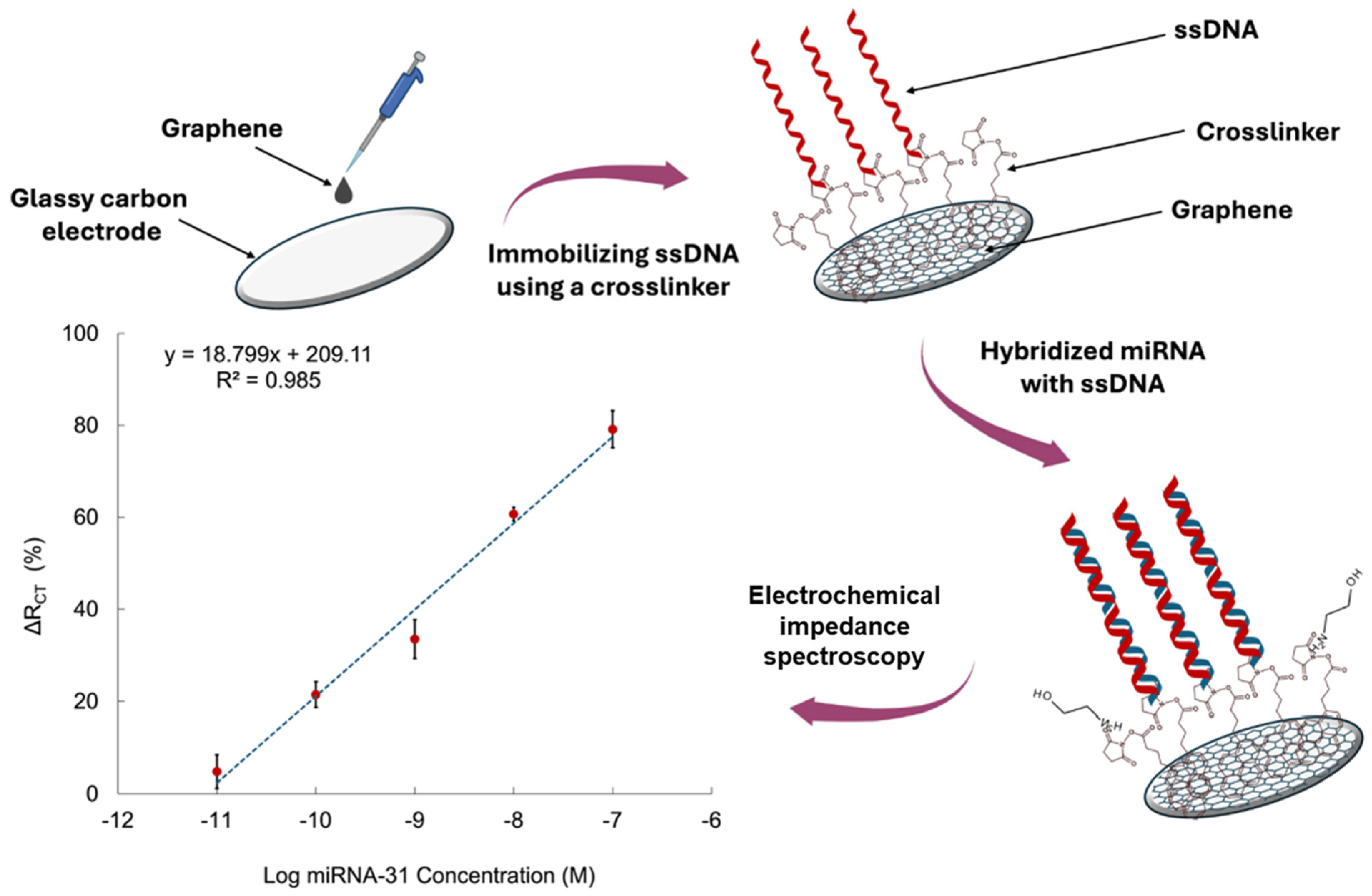
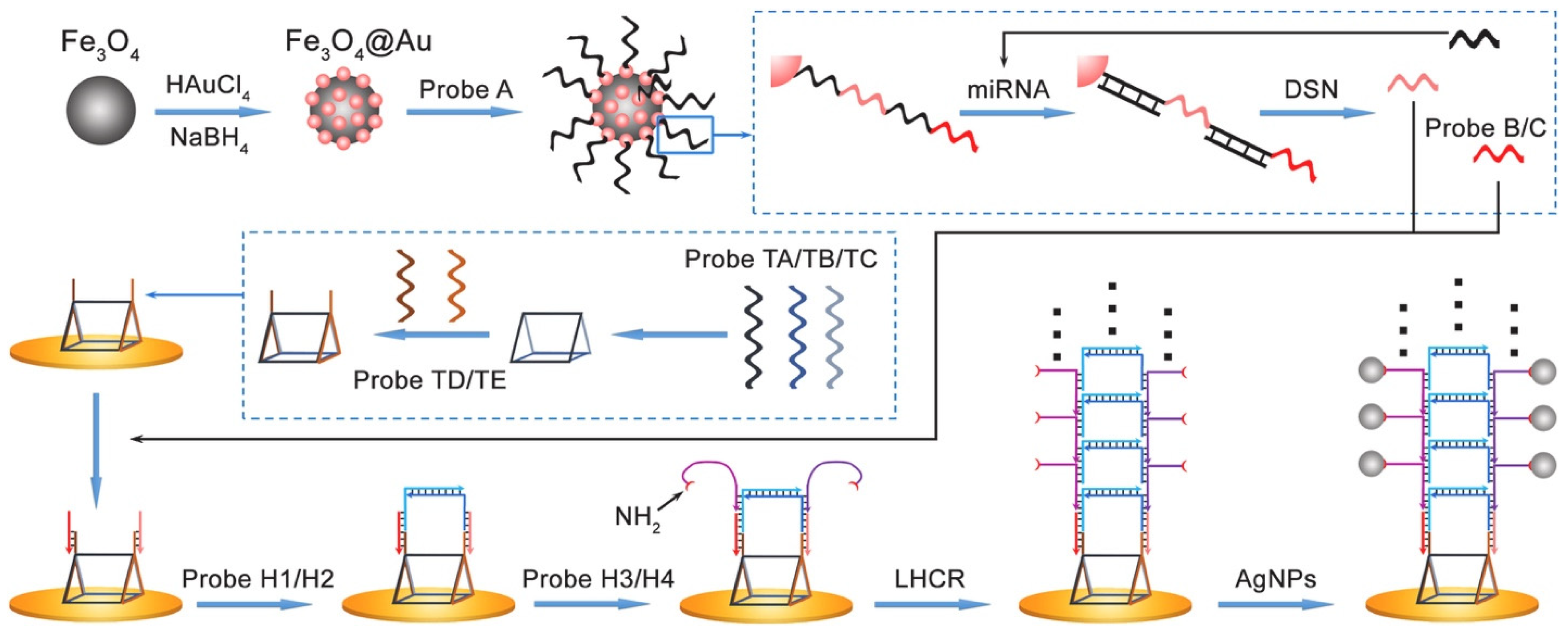


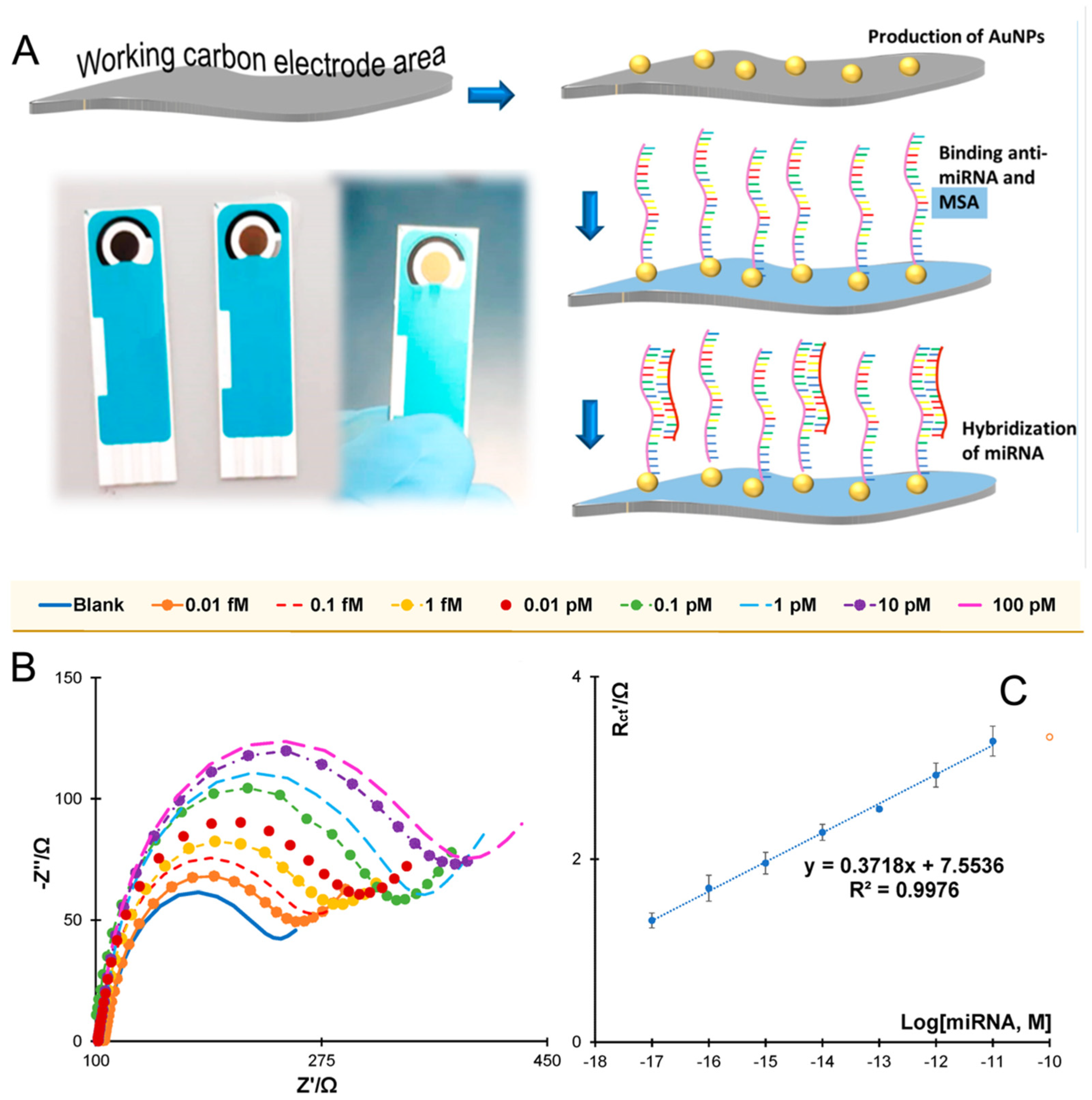
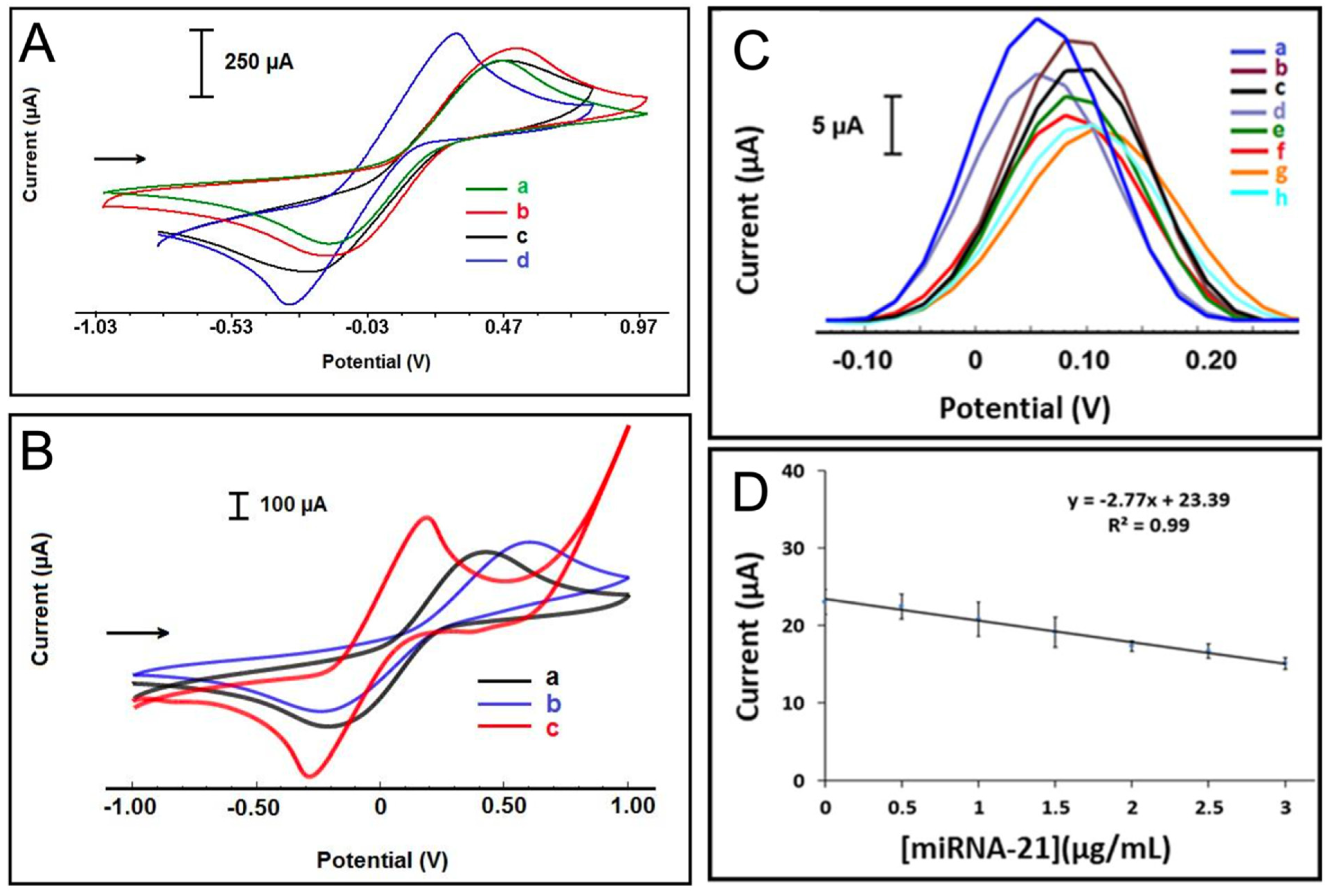
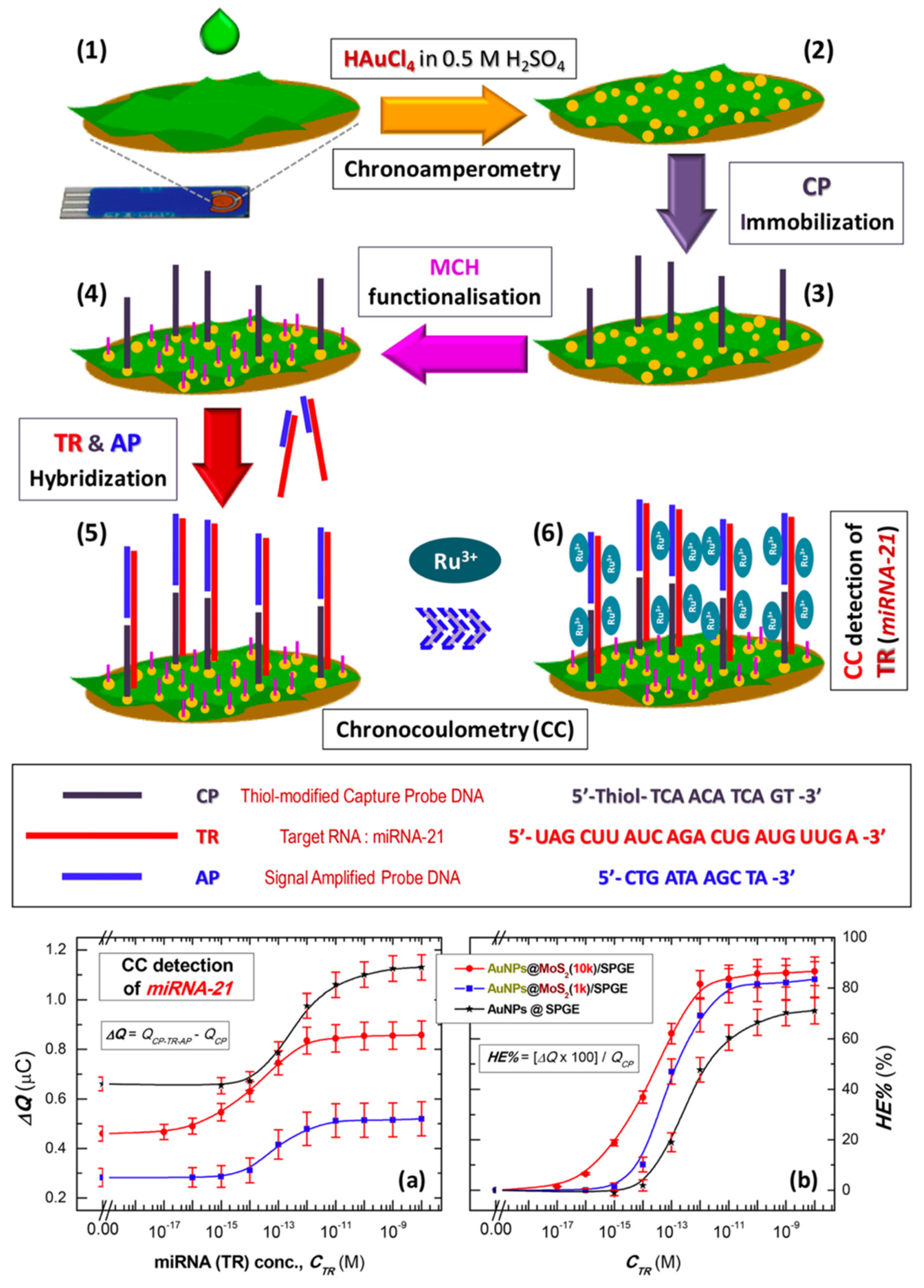

| Strategy | Mechanism | Advantages | Limitations | Enzyme Required |
|---|---|---|---|---|
| Rolling Circle Amplification (RCA) | Isothermal polymerase elongates circular DNA templates | High amplification yield; concatemeric output; compatible with surface anchoring | Long reaction time; requires circular probe design; sensitive to contaminants | Yes |
| Hybridization Chain Reaction (HCR) | Target opens DNA hairpins in a chain-like manner | Enzyme-free; biocompatible; suitable for multiplexing | Low signal intensity without enhancement; requires precise probe optimization | No |
| Catalytic Hairpin Assembly (CHA) | Autocatalytic hybridization triggered by target | Fast kinetics; enzyme-free; easy to engineer for logic circuits | Prone to spontaneous leakage; moderate amplification gain; signal saturation in high background | No |
| Loop-mediated Isothermal Amplification (LAMP) | Multi-primer isothermal DNA amplification | Rapid and exponential signal; tolerant to sample inhibitors; low equipment needs | Difficult primer design; high risk of nonspecific amplification; hard to multiplex | Yes |
| DSN Recycling | Cleaves DNA in RNA–DNA hybrids, enabling target recycling | Increases sensitivity; reduces background; robust signal | Enzyme degradation; potential cleavage of off-target sequences; storage sensitivity | Yes |
| DNA Walkers | Stepwise signal amplification through strand displacement walking | Ultralow detection limit; multi-site signal triggering; programmable dynamics | Complex synthetic routes; design-dependent signal variability; difficult standardization | Often |
| Entropy-Driven Strand Displacement | Target hybridizes and releases strands via energy minimization | Enzyme-free; scalable; highly modular for logic gates | Lower signal gain; leaky behavior if not thermodynamically optimized; slow response | No |
| Nanomaterial | Mechanism | Advantages | Limitations | Electrode Examples | LOD | Linear Detection Range |
|---|---|---|---|---|---|---|
| Gold Nanoparticles (AuNPs) | Enhance signal via probe density, electron transfer, and catalysis | Strong signal enhancement; simple thiol chemistry; good biostability | High cost; aggregation in salt-rich media; requires precise surface chemistry | GCE, SPE, ITO | aM–fM | aM–pM |
| Metal–Organic Frameworks (MOFs) | High-porosity scaffolds for probe loading and catalysis | High loading capacity; tailorable pore size; good signal-to-noise | Fragile in aqueous media; synthesis complexity; limited conductivity without hybridization | MOF/AuNP-modified GCE or SPE | fM | fM–pM |
| Reduced Graphene Oxide (rGO) | Conductive surface and scaffold for probe immobilization | Excellent conductivity; high surface area; supports diverse modifications | Biofouling in complex matrices; irreversible adsorption of non-target species; oxidation sensitivity | rGO/GCE, rGO/SPE | aM–fM | fM–pM |
| Magnetic Nanoparticles (MNPs) | Enable magnetic separation and localized concentration | Facilitates washing; reusable; good for miniaturized platforms | Poor intrinsic conductivity; prone to aggregation; may require surface modification for stability | MNPs on SPCE, Fe3O4/GCE | fM | fM–nM |
| Silver Nanoparticles (AgNPs) | Catalyze redox reactions and amplify electrochemical signal | Strong electrochemical activity; low cost; simple synthesis | Susceptible to oxidative degradation; limited long-term stability; less versatile than AuNPs | AgNP-modified GCE or ITO | aM | aM–fM |
| Carbon Nanotubes (CNTs) | Enhance electrode conductivity and loading capacity | High surface-to-volume ratio; flexible integration; low cost | Nonspecific adsorption; variable purity; difficult to uniformly functionalize | CNT/SPE, CNT-coated GCE | fM | fM–pM |
| Redox Mediator | Molecular Type | Mechanism | Advantages | Limitations |
|---|---|---|---|---|
| Methylene Blue (MB) | Organic dye | Intercalation into RNA duplex; reversible redox cycling | High specificity; well-defined redox peak | Potential nonspecific adsorption |
| Toluidine Blue (TB) | Organic dye | π–π stacking with nucleic acid bases; redox-active intercalator | Strong binding; low redox potential; stable | Sensitive to pH variation |
| Oracet Blue (OB) | Anthraquinone derivative | Intercalation and electron transfer mediation | Good redox reversibility; strong duplex binding | Lower aqueous solubility |
| Palladium Nanoparticles (PdNPs) | Metal nanostructure | Intercalative interaction with nucleic acids; redox catalysis | Catalytic amplification of signal | Synthesis complexity; possible aggregation |
| Cobalt-Phenanthroline Complex (Co(phen)32+) | Organometallic complex | Electrostatic binding and intercalation; electron shuttle | Tunable redox potential; stable coordination | Potential cytotoxicity |
| Hemin | Biomimetic molecule | Intercalation and peroxidase-mimic activity | Biofriendly; catalytic amplification | Sensitivity to oxidative degradation |
Disclaimer/Publisher’s Note: The statements, opinions and data contained in all publications are solely those of the individual author(s) and contributor(s) and not of MDPI and/or the editor(s). MDPI and/or the editor(s) disclaim responsibility for any injury to people or property resulting from any ideas, methods, instructions or products referred to in the content. |
© 2025 by the authors. Licensee MDPI, Basel, Switzerland. This article is an open access article distributed under the terms and conditions of the Creative Commons Attribution (CC BY) license (https://creativecommons.org/licenses/by/4.0/).
Share and Cite
Hunt, A.; Slaughter, G. Electrochemical Strategies for MicroRNA Quantification Leveraging Amplification and Nanomaterials: A Review. Chemosensors 2025, 13, 242. https://doi.org/10.3390/chemosensors13070242
Hunt A, Slaughter G. Electrochemical Strategies for MicroRNA Quantification Leveraging Amplification and Nanomaterials: A Review. Chemosensors. 2025; 13(7):242. https://doi.org/10.3390/chemosensors13070242
Chicago/Turabian StyleHunt, Alexander, and Gymama Slaughter. 2025. "Electrochemical Strategies for MicroRNA Quantification Leveraging Amplification and Nanomaterials: A Review" Chemosensors 13, no. 7: 242. https://doi.org/10.3390/chemosensors13070242
APA StyleHunt, A., & Slaughter, G. (2025). Electrochemical Strategies for MicroRNA Quantification Leveraging Amplification and Nanomaterials: A Review. Chemosensors, 13(7), 242. https://doi.org/10.3390/chemosensors13070242






